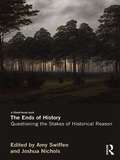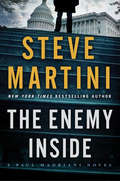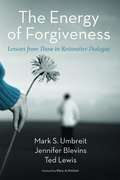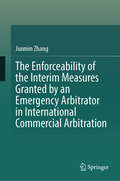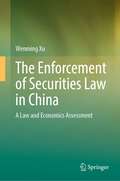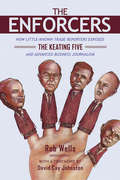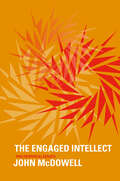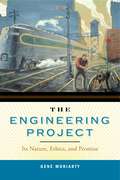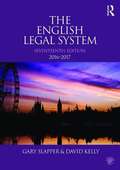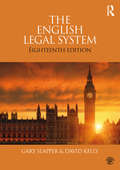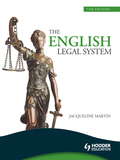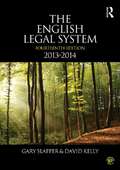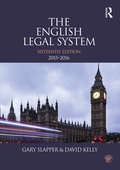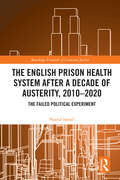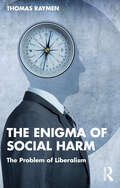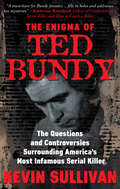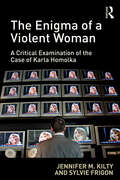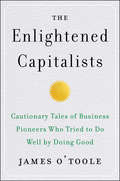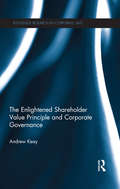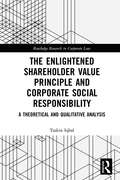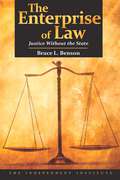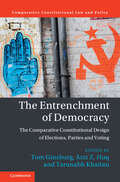- Table View
- List View
The Ends of History: Questioning the Stakes of Historical Reason (Laurier Studies In Political Philosophy Ser. #1)
by Amy Swiffen Joshua NicholsThe Ends of History? considers how, despite the fact that events in the past 20 years have called Francis Fukuyama’s infamous announcement of the end of history into question, the issue of the end of history is now a matter of renewed interest and debate. Two decades ago we were confronted by the end of the Soviet Union and collapse of the geo-political divisions that had defined much of the twentieth century. From this particular end, the ‘end of history’ was proclaimed. But is it still possible to argue that liberal democracy and free market capitalism are the final form of law and mode of production in human history? Recent events have called this thesis into question: from 9/11 and the War on Terror, to the current global economic collapse and looming ecological crises, it seems that history if far from over. And yet, oddly enough, the question of ‘the end’ has returned. For example, in the often predicted, but still uncertain, establishment of either a new international American Empire or a new era of International Law, and the global resurgence of religion as a dominant source of political identification. On the other hand, perhaps the ‘end’ is still yet to come, slowly accumulating, mustering at the periphery of the geo-political landscape and outside the productive sphere. Responses taking up these questions range from a return to Universalism, political theology, Messianism, and even the old specter of communism. This volume assesses these responses, exploring what is at stake in proclaiming ‘the end’ in the current historical moment. Is it a matter of reading the writing on the wall? Or is the proclamation itself a political act? Furthermore is there a desire for the ‘end’? In addressing these questions, the contributors to The Ends of History? confront the various ‘ends’ that we now live, and in so doing they open new lines of sight into the future.
The Endurance of National Constitutions
by Zachary Elkins Tom Ginsburg James MeltonConstitutions are supposed to provide an enduring structure for politics. Yet only half live more than nineteen years. Why is it that some constitutions endure while others do not? In The Endurance of National Constitutions, Zachary Elkins, Tom Ginsburg, and James Melton examine the causes of constitutional endurance from an institutional perspective. Supported by an original set of cross-national historical data, theirs is the first comprehensive study of constitutional mortality. They show that whereas constitutions are imperiled by social and political crises, certain aspects of a constitution's design can lower the risk of death substantially. Thus, to the extent that endurance is desirable - a question that the authors also subject to scrutiny - the decisions of founders take on added importance.
The Enemy Inside
by Steve Martini<P>In this riveting new novel in the New York Times bestselling series, defense attorney Paul Madriani uncovers a morass of double-dealing and murder that leads him to the very highest levels of American political power. <P>When a friend, Alex Ives, is implicated in a deadly motor collision on a deserted Southern California highway, Paul Madriani joins a case as tangled as any he's ever taken. Alex swears he had only one drink the night of the crash, but he also can't remember the events of the evening beyond the fact that he was to meet a sexy, mysterious woman at an elegant house party. The next morning he woke up in the hospital in police custody, charged with drunk driving and manslaughter. <P>When Paul discovers that Alex knew the deceased, a connected, hard-charging Washington, D.C., lawyer named Olinda Serna, Madriani realizes the potential penalties for his client could include a death sentence. <P>Across the country in Washington, D.C., attorney Cletus Proffit learns that his law firm nemesis, Ms. Serna, has died in California. Proffit knows that Serna protected dangerous secrets involving players moving in the highest reaches of national politics, and he will go to any lengths to ensure that that knowledge has died with her. <P>Senator Maya Grimes also hears of the fatal crash, and begins crafting her own web of deceit to suffocate anything that might come back to bite her. In the meantime, a vicious, highly effective mercenary--a woman whose calling card is the ability to kill her victims in horrifying, utterly untraceable accidents--begins to panic when she gets word of Serna's death in Southern California and the manner in which it occurred. <P>Now the only way to save a young man from imprisonment is for Madriani, his partner, Harry Hinds, and investigator Herman Diggs to uncover the corruption and dark deeds that surround Ms. Serna's friends and find her killer--before he or she can strike again. <P><b>A New York Times Bestseller</b>
The Energy of Forgiveness: Lessons From Those In Restorative Dialogue
by Mark UmbreitForgiveness is a life-changing experience for many people who have been hurt by others. But forgiveness is paradoxical in that if one relies on forgiveness language or if others prescribe it as an expectation, the depth of that experience can be significantly compromised. Many people experience deep forgiveness without ever using the language of forgiveness.New research on the benefits of forgiveness is on the rise these days, yet there is often little narrative to show the power of forgiveness.
The Enforceability of the Interim Measures Granted by an Emergency Arbitrator in International Commercial Arbitration
by Junmin ZhangThis timely book offers a comprehensive study of the emergency arbitrator mechanism that provides interim measures in international commercial arbitration before the constitution of an arbitral tribunal, focusing on the enforceability of the interim measures granted. Based on the traditional legal doctrines of private international law, international dispute resolution, and arbitration law, this book is featured mainly in comparative studies. Six leading arbitral institutions are chosen to conduct systematic research on applying the emergency arbitration rules to establish a general and common procedural framework for emergency arbitration in discussion. Normative and comparative law analyses investigate the status quo of available legal instruments used to recognize and enforce interim measures in emergency arbitration by examining international conventions and three representative chosen jurisdictions, i.e., Singapore, Mainland China, and the USA. Following these two levels of comparison, it highlights and examines the potential doctrinal and practical barriers that may impact the enforceability of interim measures rendered by an emergency arborator. Finally, it proposes various approaches that could be used to improve the enforceability controversy, and it offers innovative suggestions for further research. This book is of particular relevance and interest to students, researchers, and practitioners in dispute resolution and arbitration law, as well as policymakers, legislators, and arbitral institutions considering further reform in international arbitration.
The Enforcement of Securities Law in China: A Law and Economics Assessment
by Wenming XuThis book takes a law and economic approach to examine the securities law enforcement in China and provides an in-depth empirical analysis on the enforcement inputs and outputs. In contrast to previous studies, it systematically collects a large sample of judicated securities fraud cases and public sanctions as disclosed by the listed companies. The enforcement regime is further divided into the private enforcement exemplified by the civil litigation imitated by harmed investors and public enforcement by sanctions proceedings initiated by public agencies. Academic researchers, policy makers and practitioners, who are interested in the securities market and regulation could find the information provided in this book interesting.
The Enforcers: How Little-Known Trade Reporters Exposed the Keating Five and Advanced Business Journalism (History of Communication #148)
by Rob WellsIn the 1980s, real estate developer and banker Charles H. Keating executed one of the largest savings and loans frauds in United States history. Keating had long used the courts to muzzle critical reporting of his business dealings, but aggressive reporting by a small trade paper called the National Thrift News helped bring down Keating and offered an inspiring example of business journalism that speaks truth to power. Rob Wells tells the story through the work of Stan Strachan, a veteran financial journalist who uncovered Keating's misdeeds and links to a group of US senators—the Keating Five—who bullied regulators on his behalf. Editorial decisions at the National Thrift News angered advertisers and readers, but the newsroom sold ownership on the idea of investigative reporting as a commercial opportunity. Examining the National Thrift News's approach, Wells calls for a new era of business reporting that can—and must—embrace its potential as a watchdog safeguarding the interests of the public.
The Engaged Intellect: Philosophical Essays
by John McDowellThe Engaged Intellect collects important essays of John McDowell. Each involves a sustained engagement with the views of an important philosopher and is characterized by a modesty that is partly temperamental and partly methodological. It is typical of McDowell to represent his own best insights either as already to be found in the writings of his heroes (Aristotle, Wittgenstein, Gadamer, and Sellars) or as inevitably emerging from a charitable modification of the views of those (such as Anscombe, Sellars, Davidson, Evans, Rorty, Dreyfus, and Brandom) subjected here to criticism. McDowell therefore develops his own philosophical picture in these pages through a method of indirection. The method is one of intervening in a philosophical dialectic at a characteristic juncture—in which it is difficult to avoid the feeling that further progress is required. McDowell shows how progress is to be achieved by preserving what is most attractive in the views of those he is in conversation with, while whittling away their weaknesses. As he practices this method, what emerges through the volume is the unity of McDowell’s own views. The combination of philosophical breadth with dialectical depth—of intricate argumentative detail with overall philosophical coherence—marks McDowell as one of the most compelling philosophers of our time.
The Engineering Project: Its Nature, Ethics, and Promise
by Gene MoriartyWe all live our daily lives surrounded by the products of technology that make what we do simpler, faster, and more efficient. These are benefits we often just take for granted. But at the same time, as these products disburden us of unwanted tasks that consumed much time and effort in earlier eras, many of them also leave us more disengaged from our natural and even human surroundings. It is the task of what Gene Moriarty calls focal engineering to create products that will achieve a balance between disburdenment and engagement: “How much disburdenment will be appropriate while still permitting an engagement that enriches one’s life, elevates the spirit, and calls forth a good life in a convivial society?”One of his examples of a focally engineered structure is the Golden Gate Bridge, which “draws people to it, enlivens and elevates the human spirit, and resonates with the world of its congenial setting. Humans, bridge, and world are in tune.” These values of engagement, enlivenment, and resonance are key to the normative approach Moriarty brings to the profession of engineering, which traditionally has focused mainly on technical measures of evaluation such as efficiency, productivity, objectivity, and precision. These measures, while important, look at the engineered product in a local and limited sense. But “from a broader perspective, what is locally benign may present serious moral problems,” undermining “social justice, environmental sustainability, and health and safety of affected parties.” It is this broader perspective that is championed by focal engineering, the subject of Part III of the book, which Moriarty contrasts with “modern” engineering in Part I and “pre-modern” engineering in Part II.
The Engineering-Business Nexus: Symbiosis, Tension and Co-Evolution (Philosophy of Engineering and Technology #32)
by Steen Hyldgaard Christensen Christelle Didier Martin Meganck Mike Murphy Bernard DelahousseFascinating and compelling in equal measure this volume presents a critical examination of the multilayered relationships between engineering and business. In so doing the study also stimulates ethical reflection on how these relationships either enhance or inhibit strategies to address vital issues of our time. In the context of geopolitical, economic, and environmental tendencies the authors explore the world that we should want to create and the role of the engineer and the business manager in this endeavor. Throughout this volume the authors identify periods of alignment and periods of tension between engineering and business. They look at focal points of the engineering-business nexus related to the development of capitalism. The book explores past and present movements to reshape, reform, or reject this nexus.The volume is informed by questions of importance for industry as well as for higher education. These are: What kinds of conflict arise for engineers in their attempts to straddle both professional and organizational commitments? How should professionals be managed to avoid a clash of managerial and professional cultures? How do engineers create value in firms and corporations? What kinds of tension exist between higher education and industry? What challenges does the neoliberal entrepreneurial university pose for management, faculty, students, society, and industry? Should engineering graduates be ready for work, and can they possibly be? What kinds of business issues are reflected in engineering education curricula, and for what purpose? Is there a limit to the degree of business hybridization in engineering degree programs, and if so, what would be the criterion for its definition? Is there a place in engineering education curricula for reflective critique of assumptions related to business and economic thinking? One ideal of management and control comes to the fore as the Anthropocene - the world transformed into an engineered artefact which includes human existence. The volume raises the question as to how engineering and business together should be considered, given the fact that the current engineering-business nexus remains embedded within an economic model of continual growth. By addressing macro-level issues such as energy policy, sustainable development, globalization, and social justice this study will both help create awareness and stimulate development of self-knowledge among practitioners, educators, and students thereby ultimately addressing the need for better informed citizens to safeguard planet Earth as a human life supporting system.
The English Legal System
by David Kelly Gary SlapperSlapper and Kelly's The English Legal System explains and critically assesses how our law is made and applied. Trusted by generations of academics and students, this authoritative textbook clearly describes the legal rules of England and Wales and their collective influence as a sociocultural institution. This latest edition of The English Legal System has been substantially updated to include changes to the civil and criminal justice systems, changes in legal funding, developments in European law, and recent applications of human rights law. Key learning features include: useful chapter summaries which act as a good check point for students 'food for thought' questions at the end of each chapter to prompt critical thinking and reflection sources for further reading and suggested websites at the end of each chapter to point students towards further learning pathways; an online skills network including how tos, practical examples, tips, advice and interactive examples of English law in action. Relied upon by generations of students, Slapper and Kelly's The English Legal System is a permanent fixture in this ever-evolving subject.
The English Legal System
by David Kelly Gary SlapperSlapper and Kelly’s The English Legal System explains and critically assesses how our law is made and applied. Trusted by generations of academics and students, this authoritative textbook clearly describes the legal rules of England and Wales and their collective influence as a sociocultural institution. This latest edition of The English Legal System has been substantially updated. Slapper & Kelly can always be relied upon for accurate and reliable coverage of all of the latest developments which impact on the legal system in England and Wales. Key learning features include: useful chapter summaries which act as a good check point for students ‘food for thought’ questions at the end of each chapter to prompt critical thinking and reflection sources for further reading and suggested websites at the end of each chapter to point students towards further learning pathways an online skills network including how tos, practical examples, tips, advice and interactive examples of English law in action. Relied upon by generations of students, Slapper and Kelly’s The English Legal System is a permanent fixture in this ever-evolving subject.
The English Legal System, 7th Edition eBook ePub
by Jacqueline MartinSupport a number of intermediate law courses with this brand new edition of our bestselling introductory textbook by Jacqueline Martin.Authoritative and reliable, The English Legal System, 7th edition, ensures that students have a comprehensive understanding of the English Legal System. Written by Jacqueline Martin, who has helped hundreds of thousands pass their exams and enjoy their studies, it maintains a balance between deep insight and easy reading so students can reach their highest potential.The breadth of coverage is especially useful for A level OCR and WJEC Law students, as it covers all the necessary topics and highlights links to these specifications. The text also supports a range of other intermediate courses including ILEX, Access to HE, paralegal, international foundation programme, BTEC in Applied Law, law courses for non-law students in business, accountancy and public services plus Foundation Degree and LLB programmes.- Use diagrams, illustrations, key facts charts and activities to clarify difficult concepts and help students remember the key information- Support understanding and revision with key terms, a glossary for quick reference and examination advice- Hold your students' attention with interesting and informative cases and explanations of the law- Encourage students to question the logic and practicality of the law in England and Wales
The English Legal System: 2013-2014
by David Kelly Gary SlapperSlapper and Kelly’s The English Legal System explains and critically assesses how our law is made and applied. Annually updated, this authoritative textbook clearly describes the legal rules of England and Wales and their collective influence as a sociocultural institution. This latest edition of The English Legal System presents and analyses changes made to the legal system and digests recent legislation and case law. The Protection of Freedom Act 2012, the Defamation Bill, the Justice and Security Bill 2012, the Mental Health (Discrimination) Bill 2012, and the July 2012 vote on Parliamentary reform are all incorporated into the text, and this edition also considers changes to the Crown Prosecution Service, Mediation and Judicial Diversity. The cases Alvi v Secretary of State for the Home Department (judicial review), AXA General Insurance Limited v The Lord Advocate (Scotland) (devolution), R v J, S, M and R v KS (jury tampering), and Rolf v De Guerin (mediation) are all digested in the text. The text also includes the latest government papers on antisocial behaviour, and criminal justice reform, the Practice Direction on citing authorities in court, and the Leveson Inquiry. Key learning features include: a clear and logical structure with short, manageable, well-structured individual chapters; useful chapter summaries which act as a good check point for students; ‘food for thought’ sections help to deepen understanding of key issues in each chapter; sources for further reading and suggested websites at the end of each chapter to point students towards further learning pathways; an online skills network including how-to-do practical examples, tips, advice and interactive examples of English law in action. Relied upon by generations of students, Slapper and Kelly’s The English Legal System is a permanent fixture in this ever evolving subject.
The English Legal System: 2015-2016
by David Kelly Gary SlapperSlapper and Kelly's The English Legal System explains and critically assesses how our law is made and applied. Annually updated, this authoritative textbook clearly describes the legal rules of England and Wales and their collective influence as a sociocultural institution. This latest edition of The English Legal System presents and analyses changes made to the legal system and digests recent legislation and case law. The Protection of Freedom Act 2012, the Defamation Bill, the Justice and Security Bill 2012, the Mental Health (Discrimination) Bill 2012, and the July 2012 vote on Parliamentary reform are all incorporated into the text, and this edition also considers changes to the Crown Prosecution Service, Mediation and Judicial Diversity. The cases Alvi v Secretary of State for the Home Department (judicial review), AXA General Insurance Limited v The Lord Advocate (Scotland) (devolution), R v J, S, M and R v KS (jury tampering), and Rolf v De Guerin (mediation) are all digested in the text. The text also includes the latest government papers on antisocial behaviour, and criminal justice reform, the Practice Direction on citing authorities in court, and the Leveson Inquiry. Key learning features include: a clear and logical structure with short, manageable, well-structured individual chapters; useful chapter summaries which act as a good check point for students; 'food for thought' sections help to deepen understanding of key issues in each chapter; sources for further reading and suggested websites at the end of each chapter to point students towards further learning pathways; an online skills network including how-to-do practical examples, tips, advice and interactive examples of English law in action. Relied upon by generations of students, Slapper and Kelly's The English Legal System is a permanent fixture in this ever evolving subject.
The English Prison Health System After a Decade of Austerity, 2010-2020: The Failed Political Experiment (Routledge Frontiers of Criminal Justice)
by Nasrul IsmailAusterity has reconfigured and scaled back the governance and delivery of public services and negatively affected society’s most vulnerable groups. This book opens up the closed world of English prisons to examine its impact on prison health governance and healthcare delivery. It argues that austerity has been a decade-long, large-scale political experiment that has caused debt to balloon, eroded the prison health system and perpetuated a cycle of punishment resulting in sicker prisoners. In short, austerity has violated prisoners’ human rights. Drawing on interviews and data from existing longitudinal and economic analyses, the book demonstrates how austerity has resulted in high rates of recidivism, diminished what remains of the welfare state, and increased inequality and punitiveness. Despite a decade of failure, there is a marked political reluctance to dispense with austerity, and the governmental juggernaut continues to produce the same result. As the spectre of recession increases, caused in part by Brexit and COVID-19, these failures are ever more perilous. This book blends the interdisciplinary perspectives of criminology, public health, sociology, law, social policy, politics, and economics to enable greater understanding of the impact of austerity on health governance, prison healthcare, the prison workforce, and prisoners’ health and safety. It challenges current policy, practice and thinking, and is a must read for anyone who wants to reflect on how the political economic structure can affect the governance and delivery of healthcare services in marginalised settings, beyond prisons, and indeed beyond England.
The Enigma of Social Harm: The Problem of Liberalism
by Thomas RaymenDrawing on a novel blend of moral philosophy, social science, psychoanalytic theory and continental philosophy, this book offers up a diagnosis of contemporary liberal capitalist society and the increasingly febrile culture we occupy when it comes to matters of harm. On what basis can we say that something is harmful? How are we supposed to judge between competing opinions on the harmfulness of a particular behaviour, practice, or industry? Can we avoid drifting off into relativism when it comes to judgements about harm? In an age of deep cultural and political discord about what is and is not harmful, providing answers to such questions is more important than ever. Appraising the current state of the concept of social harm in academic scholarship and every-day life, Thomas Raymen finds a concept in an underdeveloped state of disorder, trapped in interminable deadlocks and shrill disagreements about what should and should not be considered harmful. To explain the genesis of this conceptual crisis and identify what we need to do to resolve it, The Enigma of Social Harm travels from Graeco-Roman antiquity to the present day, exploring trends and developments in moral and political philosophy, religion, law, political economy, and culture. Along the way, we see how such trends and developments have not only made it more difficult to establish a shared basis for evaluating harm, but that the tools which might enable us to do so are now outright prohibited by the political-economic, cultural, and ethical ideology of liberalism that dominates contemporary society. Written in a clear and accessible style, it is essential reading for all those interested in matters of social harm, justice, politics, and ethics.
The Enigma of Ted Bundy: The Questions and Controversies Surrounding America's Most Infamous Serial Killer
by Kevin M. Sullivan&“A must-have for Bundy fanatics, this collection fills in holes and addresses key mysteries about of one of the world&’s most infamous serial killers.&” —Katherine Ramsland, bestselling author of Confession of a Serial Killer Within these pages, you&’ll read of the many questions still surrounding this fascinating and intricate case, as well as the answers that are only now being provided here. There&’s so much more to learn, and new information is still surfacing about Bundy, his victims and his potential victims. As such, there is new testimony included from those who had a brush with the killer, and others who played their own roles in this multi-state case. In this book, Bundy case detectives Jerry Thompson of Salt Lake City, Utah, and Don Patchen of Tallahassee, Florida, talk about their personal experiences with Bundy. So does Ron Holmes, the Louisville criminologist who worked with the killer towards the end of his life. Also included are official reports that have rarely been viewed outside of the archives, along with the author&’s commentary to guide readers through them. And last but not least, is Bundy&’s final confession to Utah detective Dennis Couch just hours prior to Bundy&’s execution. In it, Bundy reveals startling facts and sparks additional questions. A must-read for those true crime readers fascinated by America&’s most enigmatic and infamous serial killer. Praise for Kevin M. Sullivan&’s books on Ted Bundy &“Provides the most in-depth examination of the killer and his murders ever conducted.&” —Dan Zupansky, host of the True Murder podcast &“This is crime writing at its very best!&” —Gary C. King, author of The Murder of Meredith Kercher
The Enigma of a Violent Woman: A Critical Examination of the Case of Karla Homolka
by Jennifer M. Kilty Sylvie FrigonKarla Homolka has proven to be a figure of enduring interest to the public and media for the last 20 years. However, despite the widespread Canadian and international public commentary and media frenzy that has encircled this case, Homolka herself remains an enigma to most who write about her. In contrast to much of the contemporary discussion on this case, this book offers a comprehensive and detailed examination of the legal, public and media understandings and explanations of Homolka’s criminality. Drawing from multiple fields of study and varied bodies of critical literature, the book uses Homolka as an object lesson to interrogate some of the narratives and conceptualizations of ‘violent women’, the problematic normative constructions of womanhood and ‘acceptable femininity’, leniency in sentencing, taboo and disgust, and questions of remorse. The authors address broad questions about how women convicted of violence are typically constructed across four sites: the courts; the academy; the mainstream media; and public discourse. This unique text is extremely important for feminist criminology and socio-legal studies, offering the first comprehensive academic effort to engage in dialogue about this important and fascinating case.
The Enlightened Capitalists: Cautionary Tales of Business Pioneers Who Tried to Do Well by Doing Good
by James O'TooleAn expert on ethical leadership analyzes the complicated history of business people who tried to marry the pursuit of profits with virtuous organizational practices—from British industrialist Robert Owen to American retailer John Cash Penney and jeans maker Levi Strauss to such modern-day entrepreneurs Anita Roddick and Tom Chappell. <P><P>Today’s business leaders are increasingly pressured by citizens, consumers, and government officials to address urgent social and environmental issues. Although some corporate executives remain deaf to such calls, over the last two centuries, a handful of business leaders in America and Britain have attempted to create business organizations that were both profitable and socially responsible. In The Enlightened Capitalists, James O’Toole tells the largely forgotten stories of men and women who adopted forward-thinking business practices designed to serve the needs of their employees, customers, communities, and the natural environment. They wanted to prove that executives didn’t have to make trade-offs between profit and virtue. <P><P>Combining a wealth of research and vivid storytelling, O’Toole brings life to historical figures like William Lever, the inventor of bar soap who created the most profitable company in Britain and used his money to greatly improve the lives of his workers and their families. Eventually, he lost control of the company to creditors who promptly terminated the enlightened practices he had initiated—the fate of many idealistic capitalists. <P><P>As a new generation attempts to address social problems through enlightened organizational leadership, O’Toole explores a major question being posed today in Britain and America: Are virtuous corporate practices compatible with shareholder capitalism?
The Enlightened Shareholder Value Principle and Corporate Governance (Routledge Research in Corporate Law)
by Andrew KeayThe enlightened shareholder value principle (ESV) was formulated during the comprehensive review of UK company law by the Company Law Steering Group in the late 1990s and early 2000’s and requires directors of companies to act in the collective best interests of shareholders. The principle was taken up by the then UK Government and is now embedded in the Companies Act 2006. The emergence of the principle constitutes an important development in corporate governance, particularly in determining what directors must consider when managing the affairs of their companies. This book explains and analyzes the nature of ESV and its contribution to corporate governance whilst also examining where it fits into the existing theoretical landscape. Andrew Keay traces the development of the principle of ESV and considers it in the context of the existing principles which have historically influenced corporate governance. In doing so, the book draws on several empirical studies thereby enabling us to gauge how the ESV principle is addressed in commercial practice. Keay goes on to compare ESV with the constituency statutes that apply in the US in order to determine whether anything can be learnt from the American experience. The book also assesses the reaction of other jurisdictions to the advent of ESV and considers what impact ESV will have on financial institutions and non-financial institutions in the aftermath of the global financial crisis.
The Enlightened Shareholder Value Principle and Corporate Social Responsibility: A theoretical and qualitative analysis (Routledge Research in Corporate Law)
by Taskin IqbalThe Enlightened Shareholder Value principle and Corporate Social Responsibility are areas of increasing academic and research interest. However, discussions on the ESV principle in relation to CSR are very limited. This book provides a critical analysis of the impact of the concept of ESV, embedded in the Companies Act 2006, on CSR and explores the scope for reform. Along with analysing existing empirical research, it presents the findings of an empirical study conducted to determine whether the concept of ESV is capable of promoting or assisting CSR. The book also examines whether implementing an ESV approach has had any impact on the CSR practices of multinational corporations that originate in the UK and operate in developing nations, as in order to assess whether the ESV principle links to CSR both its domestic and international impact need to be considered. This analysis was undertaken through the lens of a case study on the ready-made garment industry in Bangladesh, with some focus on the Rana Plaza factory disaster. This study also assists in demonstrating the changes that need to be made to improve the current situation. Lastly, the book addresses the need for reform in the area and provides possible suggestions for reform. This interdisciplinary book will be of great interest to students and scholars of corporate law, corporate governance and business studies in general as well as policymakers, NGOs and government departments in many countries around the world working in the fields of CSR, sustainability and global supply chains.
The Enterprise of Law: Justice Without the State
by Bruce L. BensonDefenders of the state&’s monopoly on lawmaking and law enforcement typically assume that any alternative arrangement would favor the rich at the expense of the poor—or would lead to the collapse of social order and ignite a war. Questioning how well these beliefs hold up to scrutiny, this book offers a powerful rebuttal of the received view of the relationship between law and government.The provision of justice and security has long been linked in most people&’s minds to the exclusive province of government monopolies. However, in this path-breaking book, Benson shows that a system of market-based institutions, rooted in the legal principle of personal accountability under a rule of law in all aspects of criminal justice, have and can deliver those services on their own, without the aid of taxation and a coercive state monopoly on the establishment and enforcement of law. In The Enterprise of Law, Benson offers a powerful rebuttal of the received view of the relationship between law and government. The book brilliantly shows that non-state institutions have and do fight crime, resolve disputes, and render justice more effectively than the state because they have stronger incentives to do so. The book offers a host of landmark findings, and here is just a sampling: The rapid recent growth of private-sector security and conflict resolution continues the effective legacy of private crime control and the common law. Protections for individual rights and private property are not the exclusive purview of government-run legal systems. Privatizing security and dispute-resolution services and contracting out to the private sector, can offer tangible benefits—namely better and more just services at lower costs.
The Enterprise of Law: Justice without the State
by Bruce L. BensonThis study will use economic theory to compare institutions and incentives that influence public and private performance in the provision of law and its enforcement. Some critics may contend that law is not an appropriate subject for "economic analysis," because it is not produced and allocated in exchange markets. To be certain, economics has a great deal to say about market institutions, but its relevance and scope are not so narrowly limited. Economic theory requires only that scarce resources be allocated among competing uses. Clearly, the enterprise of law--the use of police services, court time, and all other inputs in the process of making law and establishing order--requires scarce resources that must be allocated. Beyond that, economic theory explains human behavior by considering how individuals react to incentives and constraints.
The Entrenchment of Democracy: The Comparative Constitutional Design of Elections, Parties and Voting (Comparative Constitutional Law and Policy)
by Tom Ginsburg Aziz Z. Huq Tarunabh KhaitanThis volume of essays brings together a group of leading political scientists, legal scholars, and political theorists to describe and analyze the body of constitutional law and practice within and upon democratic institutions, in particular examining how constitutional law shapes electoral democracy. Constitutional law and practice on this question are complex and varied. This volume therefore takes a thematic and regional approach: it selects a range of key theoretical questions related to democratic constitutional design and offers a series of chapters featuring a diverse range of voices, as well as a blend of theory, qualitative studies, and quantitative methods. Readers will gain a multifaceted understanding of a phenomenon of growing importance. The volume will also be useful to students of comparative constitutionalism, who will gain a rich array of empirical evidence to stimulate further work. This title is also available as Open Access on Cambridge Core.
